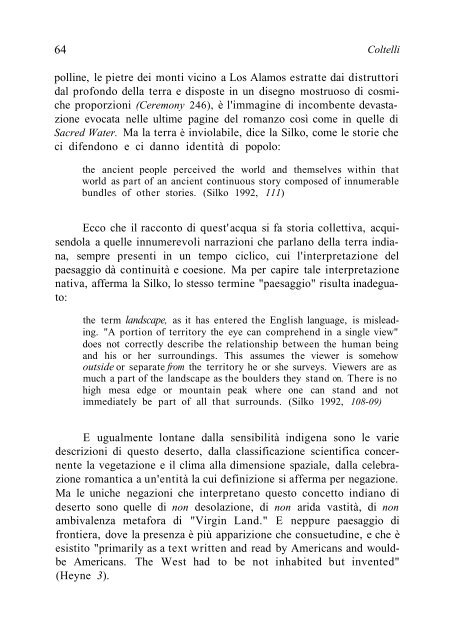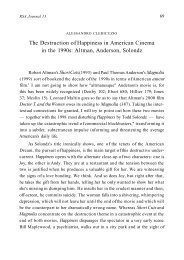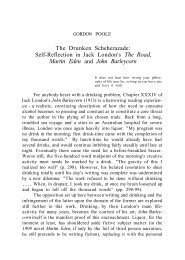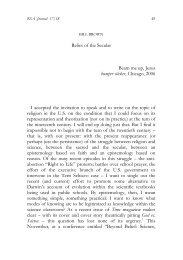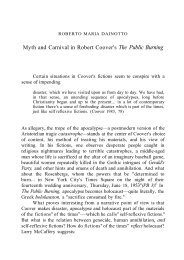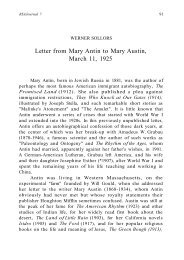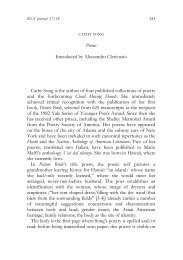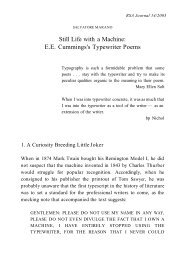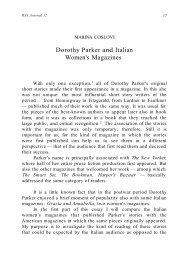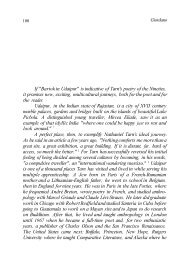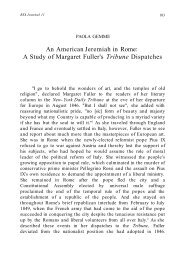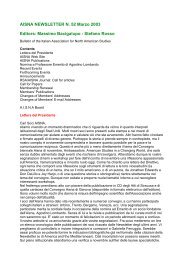Le Sacred Waters di Leslie Marmon Silko - aisna
Le Sacred Waters di Leslie Marmon Silko - aisna
Le Sacred Waters di Leslie Marmon Silko - aisna
You also want an ePaper? Increase the reach of your titles
YUMPU automatically turns print PDFs into web optimized ePapers that Google loves.
64 Coltelli<br />
polline, le pietre dei monti vicino a Los Alamos estratte dai <strong>di</strong>struttori<br />
dal profondo della terra e <strong>di</strong>sposte in un <strong>di</strong>segno mostruoso <strong>di</strong> cosmiche<br />
proporzioni (Ceremony 246), è l'immagine <strong>di</strong> incombente devastazione<br />
evocata nelle ultime pagine del romanzo così come in quelle <strong>di</strong><br />
<strong>Sacred</strong> Water. Ma la terra è inviolabile, <strong>di</strong>ce la <strong>Silko</strong>, come le storie che<br />
ci <strong>di</strong>fendono e ci danno identità <strong>di</strong> popolo:<br />
the ancient people perceived the world and themselves within that<br />
world as part of an ancient continuous story composed of innumerable<br />
bundles of other stories. (<strong>Silko</strong> 1992, 111)<br />
Ecco che il racconto <strong>di</strong> quest'acqua si fa storia collettiva, acquisendola<br />
a quelle innumerevoli narrazioni che parlano della terra in<strong>di</strong>ana,<br />
sempre presenti in un tempo ciclico, cui l'interpretazione del<br />
paesaggio dà continuità e coesione. Ma per capire tale interpretazione<br />
nativa, afferma la <strong>Silko</strong>, lo stesso termine "paesaggio" risulta inadeguato:<br />
the term landscape, as it has entered the English language, is mislea<strong>di</strong>ng.<br />
"A portion of territory the eye can comprehend in a single view"<br />
does not correctly describe the relationship between the human being<br />
and his or her surroun<strong>di</strong>ngs. This assumes the viewer is somehow<br />
outside or separate from the territory he or she surveys. Viewers are as<br />
much a part of the landscape as the boulders they stand on. There is no<br />
high mesa edge or mountain peak where one can stand and not<br />
imme<strong>di</strong>ately be part of all that surrounds. (<strong>Silko</strong> 1992, 108-09)<br />
E ugualmente lontane dalla sensibilità in<strong>di</strong>gena sono le varie<br />
descrizioni <strong>di</strong> questo deserto, dalla classificazione scientifica concernente<br />
la vegetazione e il clima alla <strong>di</strong>mensione spaziale, dalla celebrazione<br />
romantica a un'entità la cui definizione si afferma per negazione.<br />
Ma le uniche negazioni che interpretano questo concetto in<strong>di</strong>ano <strong>di</strong><br />
deserto sono quelle <strong>di</strong> non desolazione, <strong>di</strong> non arida vastità, <strong>di</strong> non<br />
ambivalenza metafora <strong>di</strong> "Virgin Land." E neppure paesaggio <strong>di</strong><br />
frontiera, dove la presenza è più apparizione che consuetu<strong>di</strong>ne, e che è<br />
esistito "primarily as a text written and read by Americans and wouldbe<br />
Americans. The West had to be not inhabited but invented"<br />
(Heyne 3).


